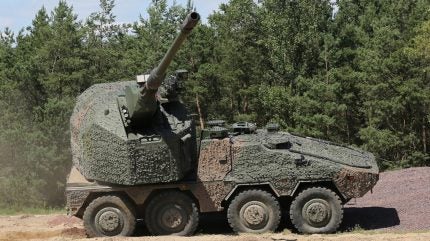
Ukraine will be the first nation to deploy the Remote Controlled Howitzer-155 (RCH-155) self-propelled artillery system, developed by the German armaments manufacturer KNDS.
Germany’s Defence Minister Boris Pistorius took delivery of the first unit at the KNDS site in Kassel on 13 January 2025, where he passed it on to Ukraine’s Ambassador to Germany, Oleksii Makeiev.
In total, Ukraine will gain 54 howitzers, the first six systems are scheduled for 2025.
However, the two countries were initally contracted for the delivery of 18 RCH 155s in July 2022, though the order increased in 2023 for a further 36 units. This corresponds to three artillery battalions.
This transfer comes nearly a year after the German Armed Forces had begun testing the howitzer.
The weapon combines a new development of the Panzerhaubitze (PzH) 2000 L52 gun, with its automated firepower of nine rounds per minute, and a range of 54km+ depending on the ammunition, alongside the armoured protection of a Boxer vehicle. Only two crewmen are needed to operate this long-range artillery system.

US Tariffs are shifting - will you react or anticipate?
Don’t let policy changes catch you off guard. Stay proactive with real-time data and expert analysis.
By GlobalDataThe support comes even before the Bundeswehr has acquired its own systems, which Makeiev noted, stating “that’s how allies treat each other: they close security gaps, especially when these gaps are bleeding wounds.”

Deployed against the Russians
This transfer demonstrates the greater sense of European unity and the continental policy of collective defence against Russia. However, it also offers users the chance to see how the system operates sooner.
The RCH platform is not unlike other forms of security aid partners have donated, says GlobalData defence analyst James Marques.
“In terms of calibre and ammunition, the RCH is already similar to other artillery given to Ukraine – it’s the PzH 2000 mounted on a wheeled chassis, and with a new remote and automated fire control system.”
It’s not changing the shape or nature of the artillery fighting, but does what it needs to do a lot faster.”
James Marques, GlobalData defence analyst
International partners have already delivered 36 PzH 2000s to Ukraine, of which Germany alone has supplied 25 units.
“It can shoot, move and respond to requests for fire much more efficiently. It’s not changing the shape or nature of the artillery fighting, but does what it needs to do a lot faster. I think this is also a good choice for the UK’s replacement for AS90.”
Other RCH 155 users
Many nations are interested in the system, and a handful already intend to adopt RCH 155. The latter include Germany and the UK, while Switzerland will integrate the RCH Automatic Gun Module to its Piranha IV vehicles.
Notably, the UK ditched its competitive acquisition process in which the South Korean K9A2 artillery system was formerly in the running against the RCH.
However, since the RCH selection in April 2024 the British user has gone back on its claims that the RCH platforms will reach Minimum Deployable Capability by 2029. Currently, the Ministry of Defence have no timeline for platform delivery.


